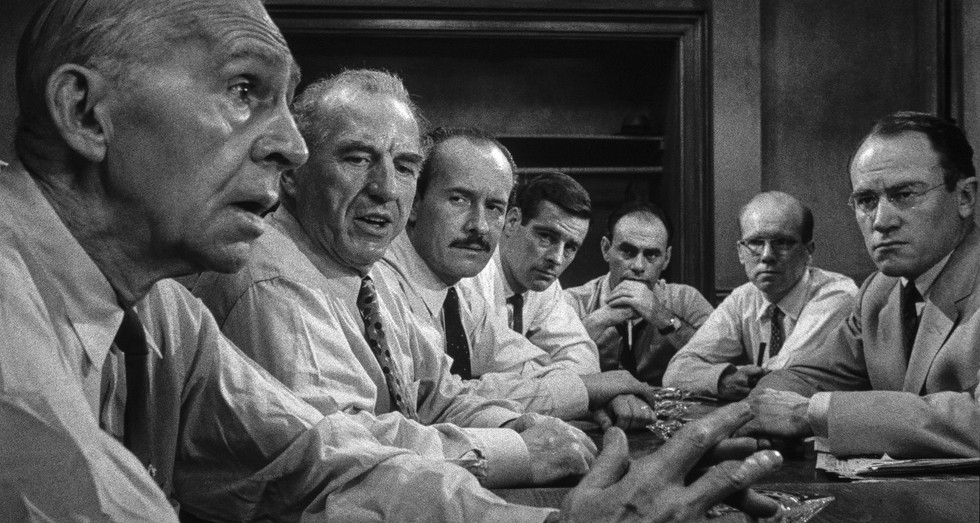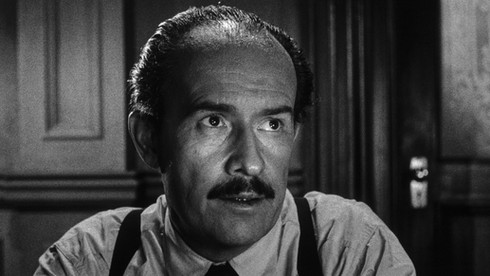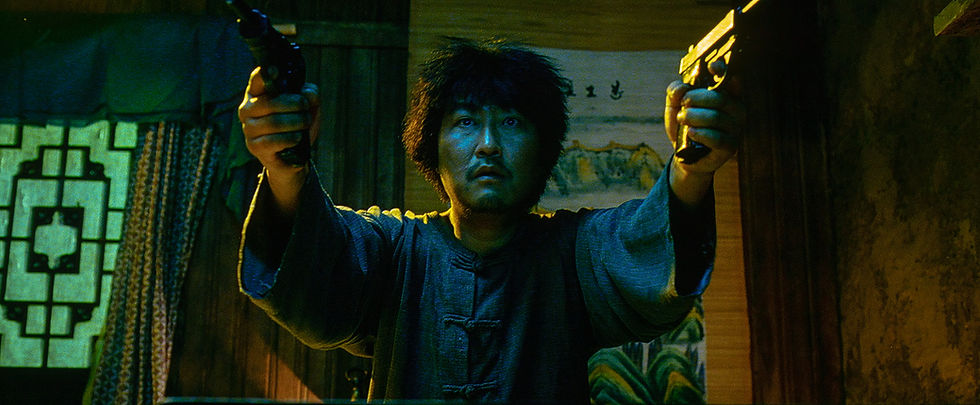Seeking Justice – “12 Angry Men” – 4K Ultra HD
- Bill Kelley III

- Apr 21, 2023
- 5 min read
Updated: May 3, 2023
4K ULTRA HD REVIEW / HDR FRAME SHOTS

Inside the New York City Jury Room, Juror No. 8 (Henry Fonda) and Juror No. 3 (Lee J. Cobb) recreate how the murder possibly happened.
(Click an image to scroll the larger versions)
“12 ANGRY MEN”
4K Ultra HD; 1957; Not Rated
Best extra: “Beyond a Reasonable Doubt” featurette
SERVING ON a jury can be life-altering; just ask television writer Reginald Rose. At the height of McCarthyism, he and 11 men decided on the case of a homeless person who stabbed a man. The great debate was over manslaughter, assault or something else. Eight hours of deliberations sparked an interest in Rose and in the whole legal system.
Afterward, Rose conceived “12 Angry Men” in a few months, originally a CBS teleplay that aired on Westinghouse “Studio One” September 20, 1954. The story follows a deadlocked jury, 11 to 1 over whether to sentence an 18-year-old to the electric chair for stabbing his father to death. Juror No. 8 – played by Robert Cummings – questions the mob mentality of his fellow jurors as he reflects on the guilt or innocence of the young man who has been abused by his father. The suspenseful drama was released on a 2011 Blu-ray and DVD set from The Criterion Collection, taken from low-grade TV cameras of the ‘50s, it’s extremely fuzzy. Many critics consider “12 Angry Men” one of three teleplays that changed the dynamics of live TV – along with “Marty,” Paddy Chayefsky’s story of a Bronx butcher starring Rod Steiger, and Ron Serling’s “Patterns,” which follows a corporate squabble between a ruthless boss, an aging employee and the upcoming vice president played by Richard Kiley. “Twelve Angry Men” swept the Emmys, winning Best Program, Best Actor (Cummings), and Best Writer (Rose).
(1-3) The 12 jurors are given instructions by the judge and leave courtroom No. 228. Juror No. 6 looks back toward the Puerto Rican youth accused of killing his father. (4) “12 Angry Men” premiered in Los Angeles on April 10, 1957. (5) Juror No. 8 and Juror No. 7 enter the jury room with two different viewpoints of the murder case. (6) The first show of hands if the 18-year-old is guilty or not guilty of killing his own father.
EXTRAS The bonus Blu-ray houses the majority of the extras including the 2008 carryover featurette “Beyond a Reasonable Doubt.”
Legendary actor Henry Fonda (“The Grapes of Wrath,” “Once Upon a Time in the West”) first took an interest in “12 Angry Men,” but Hollywood turned him down. So he and Rose raised nearly $350,000 and picked first-time director Sidney Lumet (“Network,” “The Verdict”), who got his start as a stage actor, then directing on Broadway and live TV dramas. “Like Reginald Rose, Lumet had a lot of experience in television,” says Patricia King Hanson, former Executive Editor at American Film Institute. The late Robert Osborne, host of Turner Movie Classics provides an insight along with Lumet. “I knew Reggie’s work very well, and he tended toward sentimentality,” the director says. “He so believed that people were good… and to have a script of that dimension and richness of character was so very lucky.” Lumet orchestrated a brilliant production. He storyboarded every shot, especially when using a crowded, static set for the jury room. He rehearsed his amazing cast, which included Fonda (Juror 8), Martin Balsam (Juror 1), John Fiedler (Juror 2), Lee J. Cobb (Juror 3), E.G. Marshall (Juror 4), Jack Klugman (Juror 5), Edward Binns (Juror 6), Jack Warden (Juror 7), Joseph Sweeney (Juror 9), Ed Begley (Juror 10), George Voskovec (Juror 11) and Robert Webber (Juror 12) for two weeks. The production, with 356 separate takes, wrapped up in 21 days. Osborne only had high praise for Lumet, “You know when you’re young and brave, you can do anything.”
The unorthodox film bombed, but still received three Oscar nominations – Best Picture, Best Director and Best Screenplay from another medium. Over the years, it’s become required viewing for film school students and a favorite on the art house circuit. It landed at No. 87 on the American Film Institute’s Top 100 Movies of All-Time list.
Also included is the 2008 featurette “Inside the Jury Room” with interviews from a number of prominent attorneys including Jamie Floyd, former Court TV anchor, and UCLA Law Professor Michael Asimow. Both detail how the U.S. Constitution guarantees the right to trial by a jury, and “that’s incredibly unique” on the world stage Floyd says. “12 Angry Men” reveals the racial shortcomings of the 1950s, as the jury room is cast with 12 white men. Not until 1973 did women have the right to serve on a jury in all 50 states. “I think ’12 Angry Men’ portrays the essence of the criminal justice system – and its juries and jury deliberations,” says defense attorney Robert Shapiro, who led O.J. Simpson’s dream team of attorneys. “Still, every lawyer in every single cast is looking for the same type of juror – one that will vote for them.”
There’s also a nearly two-hour 1997 Showtime version of “12 Angry Men” directed by William Friedkin (“French Connection”), which was sourced from a 2K scan of the camera negative (1.85:1 aspect ratio). The juror room has been updated with a much more diverse pool of jurors including old timers Jack Lemmon (Juror 8) and George C. Scott (Juror 3), Ossie Davis (Juror 2), Armin Mueller-Stahl (Juror 4), Courtney B. Vance (Foreman Juror 1), Dorian Harewood (Juror 5), James Gandolfini (Juror 6), Edward James Olmos (Juror 11) and Mary McDonnell as Judge Cynthia Nance. It received six prime-time Emmy nominations and won for Outstanding Sound Mix and Outstanding Supporting Actor for Scott.
The 4K disc includes two commentary tracks, one with film historian/screenwriter Gary Gerani, and the second track with Professor Drew Casper of the USC School of Cinematic Arts. Both offer in-depth perspectives with Lumet’s nearly seven-minute continues take opening that introduces the 12 characters.
Oscar-winning cinematographer Boris Kaufman (“On the Waterfront”) spent seven hours just setting up the lights for the shot. “It’s one of the most amazing shots in director Lumet’s solid canon and of all post-war cinema,” Casper says. The viewpoint starts from a static shot over a small metal fan as the title and credits roll, then the camera, mounted on a crane, moves toward the right side of a long table as the jurors move in and out of the frame. Then it moves to the left side as the additional jurors are introduced to the audience. Take No. 4 was the perfect take.
VIDEO The imagery for “12 Angry Men” was taken from a 4K scan of the original open matte 35mm camera negative (matted 1.85:1 aspect ratio). The overall sharpness is first-rate, while the heavy, natural film grain gives the black-and-white film its grittiness. The camera bounces from juror to juror with intense close-ups, pinpointing the debate of guilt or innocence.
The Kino Lorber HDR10 and Dolby Vision grading provides an expanded level of grayscale, especially in mid-tones, and more detail in the highlights – compared to the 2011 Criterion Collection Blu-ray was matted 1.66:1. Peak brightness hits 1000 nits and averages a low 26 nits, while the video bitrate ranges from 50 megabits per second to over 90 Mbps, averaging nearly 80 Mbps, all to extract every single ounce of film grain. MGM/UA continues to be Hollywood’s best in exporting its catalog of 4K masters without any film grain manipulation.
AUDIO
The 4K disc features a two-channel DTS-HD Master Audio track that has been restored removing pops, hiss, and noise. The dialogue-driven story is front and center and crisp and well-balanced with Kenyon Hopkins’ simple score.
There’s no deliberation in picking up this American classic on 4K. — Bill Kelley III, High-Def Watch producer
The 12 Jurors
Juror No. 1 & Foreman (Martin Balsam), Juror No. 2 (John Fiedler), Juror No. 3 Lee J. Cobb, Juror No. 4 E.G. Marshall, Juror No. 5 Jack Klugman, Juror No. 6 Edward Binns, Juror No. 7 Jack Warden, Juror No. 8 Henry Fonda, Juror No. 9 Joseph Sweeney, Juror No. 10 Ed Begley, Juror No. 11 George Voskovec and Juror No. 12 Robert Webber






























































Comments